There has been a trend recently of people wanting to fight insect infestations by organic/natural methods with the emphasis on companion planting and using Poached Egg Plants in particular. The problem with that as far as I can see is that there doesn’t seem to be much relevant information out there so I thought it was about time to dedicate a post on the subject.
What Is A Poached Egg Plant
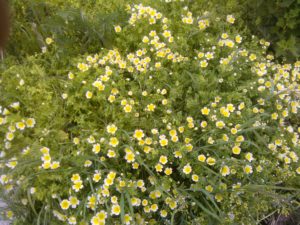
The Poached Egg Plant (Latin name Limnanthes Douglasii) is an annual plant with open flowers that are white around the outside with a yellow middle that resembles a poached or fried egg (as seen above). The Poached Egg Plant has a very shallow root system which means you don’t have to worry about struggling to get rid of them if they begin to overcrowd the growing area. The main reason the Poached Egg Plant has become so popular is because of the benefits it can bring when companion planting.
So what does it do?
What Is Poached Egg Companion Planting And Why Do It
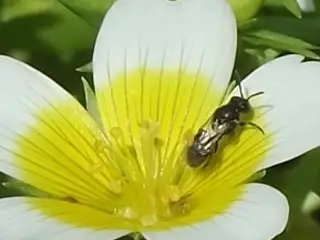
One of my attracted hover flies from companion planting with poached egg plants!
First I want to give a brief explanation on Companion Planting. Companion planting is a system of growing plants of various varieties together as a means of using each other to grow better, stronger and healthier (more on that here).
The main benefit of Companion Planting with Poached Egg Plants is that they attract beneficial insects like: Hover flies, Lacewings and Ladybirds (Ladybugs).
These beneficial insects along with their larva will feast on the Aphids (which attack plants) leaving your plants in a much healthier state and able to grow unimpeded.
What Do Aphids Do To Your Plants
Aphids feast on the soft growth of plants – either the leaves, stems, flowers or stalks and suck out the sap which is intended to feed and nurture the plant. This, of course, leaves the plant vulnerable to all number of viruses and infections. If the plant survives the attack it will be unable to produce good quality fruits or vegetables.
On another note
Aphids secrete a faecal liquid known as Honey Dew which is a sweet, sticky substance that ants feed on. Ants often “farm” aphids, moving them onto plants just so they can produce more honey dew for them to eat. Honey dew can also develop into a black mould that can hinder plants ability to photosynthesise.
What To Plant Poached Egg Plants With

Companion Planting With Poached Egg Plants to help keep Aphids at bay
I can’t think of many plants that don’t get attacked by aphids of one type or another, so companion planting with poached egg plants is almost always going to be a good idea. There are hundreds of different types of aphids that attack different plants, the good news however is that the hover flies, lacewings and ladybirds don’t discriminate – they’ll eat them all. Some plants are more prone to attack than others and in my own personal experience the main plants at risk are:
- Broad Beans
- Runner Beans
- Dwarf Beans
- Roses
- Squashes
- Cucumbers
- Melon
- Potatoes
- Beetroot
- Chard
Bare in mind, this is not an inclusive list, just what I have had good results with (let me know about your experiences too!)
How To Grow Poached Egg Plants

Poached Egg Plants are fairly resilient and will grow pretty much anywhere, however
they prefer to be planted in full sun light and in soil that drains easily.
In the UK sow seeds between March and June and expect flowers from June to September. Poached Egg Plants can be sown directly into the soil. Simply prepare the soil by clearing weeds and raking to a fine tilth (a fine crumbly texture). Make a trench roughly half an inch deep and sow your seeds, cover with soil and water in.
Keep the area moist but not waterlogged and in about ten to fifteen days your Poached Egg Plants will start appearing. Once they have established, even though they are annual plants (only grow for one year) they are very prolific seeders so you should maintain a steady supply every year.
If you don’t have much room and you’d like to grow poached egg plants in pots click here for more information.
Alternative Plants To Poached Egg Plant Companion Planting
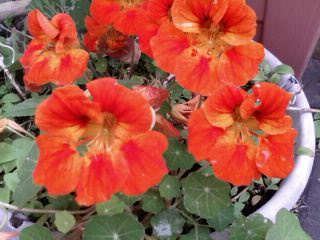
Sacrificial Nasturtium Plant
Other plants can be used as attractors for hover flies, ladybirds and lacewings these include:
- Mint
- Fennel
- Dill
- Yarrow
Although I have always found my best results have come from Poached Egg Plants, which are also much prettier and pleasing to the eye.
Another way to deal with aphids without going down the chemical route is planting a sacrificial Nasturtium plant which seem to attract aphids like no other. This means that the Nasturtium plant will take the brunt of the attack leaving your plant you are trying to protect, safe. This is an effective way but slightly unfortunate as Nasturtiums are also extremely pretty (and edible).
There are many other plants that can be used as companion plants, if you want to find out more click here.
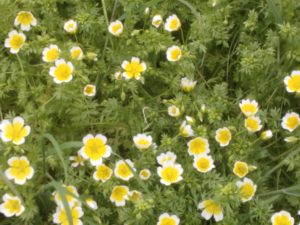

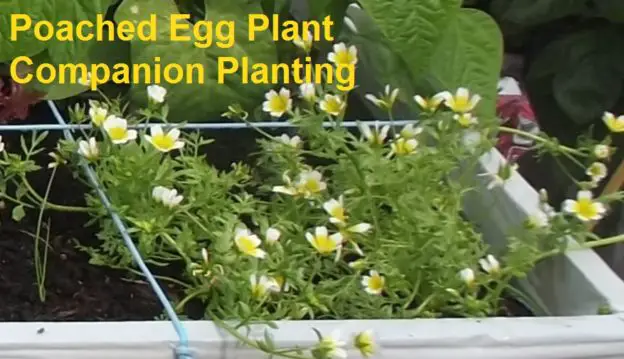
Timely, and very helpful. Thank you.
Thanks very much Angela and thanks for taking the time to read and comment.
Thanks for writing this article, which is very helpful. We have just bought some seeds after seeing the Poached Egg Plant grown alongside veggies at a National Trust property. What I would like to ask is, does this plant seed so freely that it might end up blowing around other people’s allotments? If so, I might have to keep it for my garden!
Thank you.
Hi Lindsey, I’ve been growing poached egg plants for years and I’ve never had a problem with them spreading as far as anyone else’s plot. They do spread seed freely but it tends to stay fairly close to the original planting area. If I was your neighbour I would be glad to recieve such a beneficial ally. Seriously though I don’t think they will cause you or your neighbours any problems and the young plants are easy to transplant to wherever you need hoverflies to combat aphids. I would keep some for the garden as well they are a very pretty plant and you can never have enough pollinators. I hope this helps, happy gardening.
Thank you Steve. this is just what I wanted to hear. I have 100 seeds so hopefully I’ll have plenty. Thank you also for your other articles too, which I’m finding very helpful.
Best wishes
Lindsey
Hi Lindsey, poached egg plants germinate easily so you should have lots of plants and beneficial insects as well. Thank you for your kind words and also for taking the time to both read my posts and comment. I really appreciate it.
I have a whole pot of these growing on the verge of flowering. I hadn’t a clue what they where so this is how I found your article. I will split them in the ground between cucumbers, marrow, beans,peas and will put a couple in my hanging baskets as they do look rather pretty. Your article is really good thank you
Thanks Paula and thank you for taking the time to read my post. Enjoy your gardening and your poached egg plants.
Thank you, I have never seen these in Australia before, but found them in store that buys excess good from over seas, Reject Shop.
I planted them under my standard roses without knowing about the companion planting, so now my roses should be affidavits safe.
Thank you for your information.
Gloria Whitfield
Hi Gloria,
Growing garlic around roses will help as well in fact I wrote all about how to get rid of aphids on roses in another post heres the link if you’re interested https://growing-guides.co.uk/how-to-get-rid-of-aphids-on-roses-without-chemicals/
Thanks for taking the time to read my posts and to comment as well.
Very helpful article, thank you for taking the time to help others accieve a beautiful garden.
Jo and Darren (pretty new to gardening)
Hi Joanne,
Thank you for your kind words, keep at it, it’s a hobby that never fails to surprise. After all these years I’m still learning and still enjoying the journey. I hope your garden is doing well.
I have two espaliered apple trees growing very near my 4′ x 8′ raised vegetable garden. The apple trees are growing parallel to the 8′ side of the garden, about 1 foot away, and I am training them with three rows at a total height of about 4′. The trees have become infested with wooly aphids. I’m constantly trying to wash them with soap and water, but the fuzz comes back quickly. If I were to plant the poached egg plant alongside my vegetables in the raised garden bed, so you suppose the beneficial insects attracted would venture over to help my trees out?
Hi Michael,
I’m sorry to hear of your infestation, my advice would be to continue washing the aphids away with soapy water and grow some poached egg plants as well. It sounds like you have a well established aphid problem there, so a soapy wash to remove the current pests and poached egg plants and any other aphid predator attracting plants like yarrow, marigolds, nasturtiums, dill, the problem is your particular problem is already entrenched, but by growing poached egg plants etc… will help to adress this problem in future seasons.
Dill is a great one for attracting parasitic wasps that will decimate the woolly aphids but again this is more for prevention than cure. If the apple espaliers are relatively healthy, the woolly aphid infestation shouldn’t cause too much of a problem, and hopefully they’ll survive this years onslaught and with plants in place to attract the beneficial insects for next season all will be well. I hope you find this answer helpful.
Kind regards
Steve